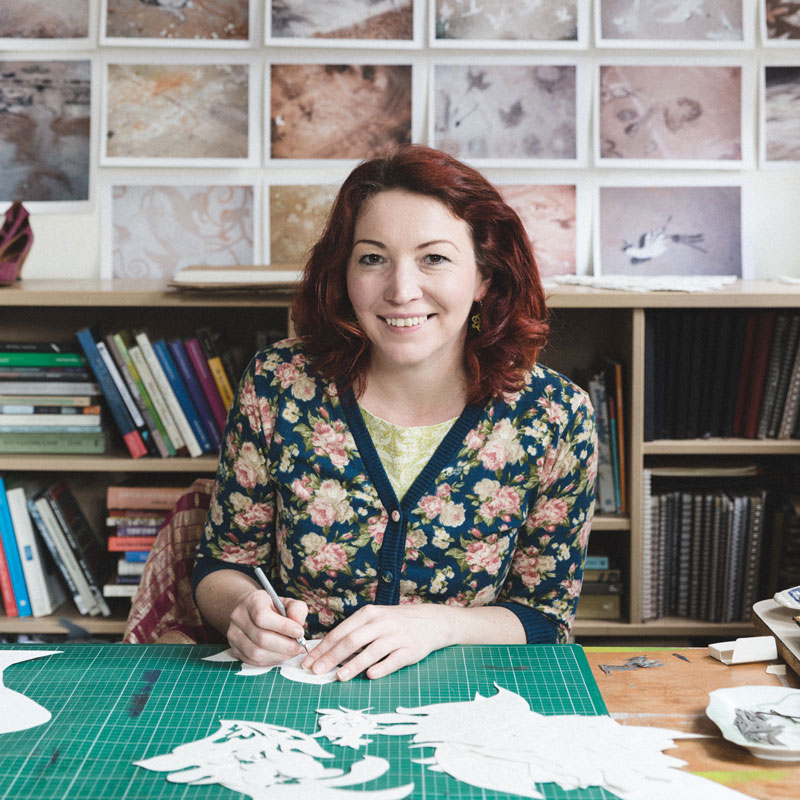Melbourne artist Hannah Bertram is not in one place for too long, with recent major projects in Singapore and Paris, and frequent trips to the US.

You could describe her in the same way as her work; fleeting in duration, evolving over time and existing in a fluid state of becoming… and disappearing.
Using dust and ash as principle materials, Hannah plays on the ambiguity of value and the concept of time to deliver temporary installations around the world.
Dust is an unusual medium to work with. How did you arrive at this?
I was a painter for about 10 years, and I was coming to the point where I just didn’t feel like painting was a medium that was expressing what I wanted to express any more. I decided that I would try everything that I possibly could as a way to figure out what I was trying to say.
During my Master of Fine Art at RMIT University, I started to investigate discarded and overlooked materials – things like scrap paper, junk mail, dirty water, orange peel, Minties wrappers – and I would embellish and bead them and transform them into something precious. Now my whole practice is concentrated on making decorative temporary work out of dust.
We’ve managed to get you between international jaunts – what have been the highlights of your recent trips?
One of the beauties of being an artist is that you get to see a city in a completely different way. I was in Paris creating the largest work I’ve ever made for the Palais de Tokyo, Pheonix in Ruins. It was three walls, one about 40 metres by ten metres, with flocked wallpaper of intricate patterns constructed out of dust.
While I was in Paris I got to gather dust in the catacombs. As a burial site it’s got the dust of thousands of dead Parisians.
What interested me is the colour of the dust, it’s got this beautiful cream colour because the catacombs used to be the quarry where they dug up the stone for all the buildings in Paris; that warm cream colour of the Arc De Triomphe and Notre Dame.
What inspired you to get into art?
It’s something I’ve always done. I’ve always made things, all the way through my childhood and teenage years. There were a lot of bad paintings early on, but I was always drawing and making stuff. Clothes, cards, pictures, things like that.
I couldn’t imagine being an artist at that point, sometimes you don’t really believe your own dreams but you keep doing it because you love it.
It got to the point where other people kept suggesting ways in which I could be creative without actually being an artist, and I realised I didn’t want to become a graphic designer or fashion designer or anything like that, my primary interest was in actually being an artist.
So how did you eventually make the commitment to making art your career?
I first did some research into other artists who have got careers that I would like to have, what they did, where they’ve exhibited, what prizes they’ve won, and then focused my attention on finding a path for myself.
I decided that I would give myself ten years to become a full time practicing artist, and if I’ve got nothing at the end of ten years – no shows, no work – then I’ll be done with it. But I’m going to give it everything I’ve got for that period.
What helped you succeed in those ten years?
I felt that I hadn’t really developed enough of a network yet, and I had only just started finding a way to conceptualise what I was trying to do, so I did a Master of Fine Arts at RMIT. The teachers have an incredible ability to reflect back and articulate what is happening in your work. Their depth of knowledge is so useful because they’re able to question you in a really productive way, not in a way that undermines what you’re doing, but that challenges you to know why you’re doing what you’re doing.\
My philosophy is, ‘I do it because I must’. That’s it. There’s no ‘it’s too difficult’, or ‘it’s not possible’. You’re not going to get anywhere if you don’t feel like you have to.
What advice do you have for people looking to become artists?
Don’t limit yourself to Australia! It is a supportive place for emerging artists and there are a lot of opportunities, which are really fantastic, but I think it’s really valuable to think internationally. This isn’t because of any cultural cringe, it’s simply a recognition that we’re working within an international dialogue, and artists need to participate more broadly than their own city.
How important is the studio to you?
I first moved into a studio while I was studying the Master of Fine Arts. I loved having a communal space with other artists in the Masters program, because they have usually had a period of developing their own practice and they’re serious, committed and deeply engaged and really want to be there. They’re all striving like you, and you can nurture and support each other.
Nowadays, I am very, very dedicated about making sure I come to the studio every day, even if I didn’t know what I was doing and I just swept the floor or read a book or something. Being in the space is the only way to make more work, and the more work you make the more you want to make.
You may also be interested in:
Find the right course for you
With over 350 qualifications to choose from, it's never been easier to find the right fit.



